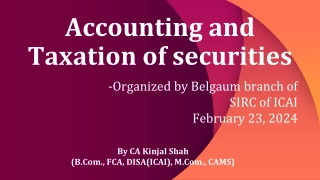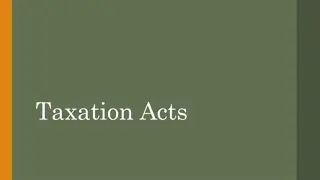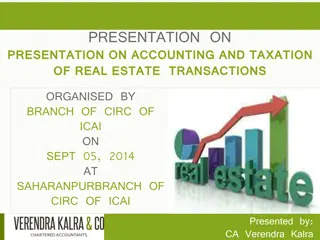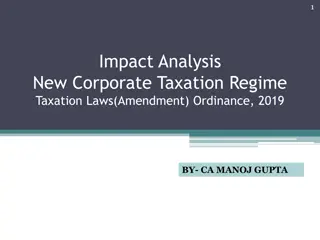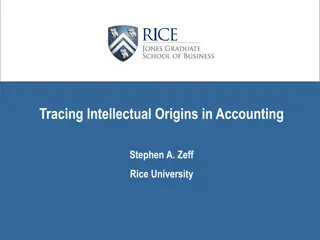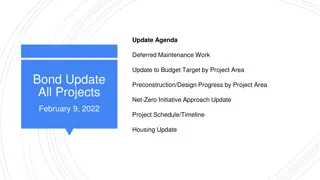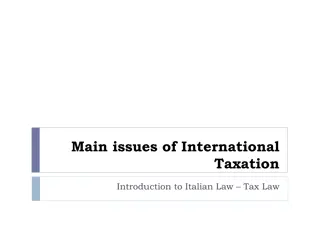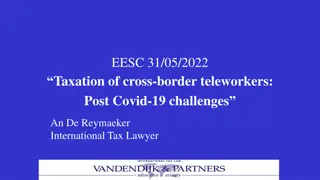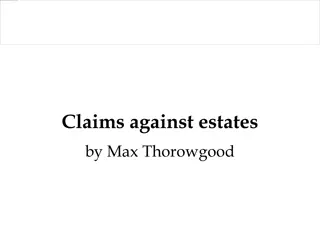Understanding Deferred Taxation in Accounting
Deferred taxation in accounting arises due to differences in financial statement preparation and tax regulations, leading to provisions for future tax obligations. It involves estimating tax liabilities based on future tax legislation and accounting treatments. Provisions, such as for doubtful debts, reflect uncertainties and are reported in financial statements. Variances between accounting and tax calculations can be temporary or permanent differences in asset/liability values and reporting methods.
Download Presentation

Please find below an Image/Link to download the presentation.
The content on the website is provided AS IS for your information and personal use only. It may not be sold, licensed, or shared on other websites without obtaining consent from the author. Download presentation by click this link. If you encounter any issues during the download, it is possible that the publisher has removed the file from their server.
E N D
Presentation Transcript
[[insert heading]] Deferred Taxation - 2019 1
Deferred Taxation Deferred taxation is an accounting and not a tax concept The primary cause giving rise to deferred taxation can be attributed to the standards governing the preparation of financial statements (accounting frameworks) and the regulations governing the computation of taxation Deferred taxation represents a provision for future tax obligations results different treatments of transactions for accounting and tax purposes 2 Deferred Taxation - 2019
Accounting Provisions A provision represents a liability (present obligation which will be fulfilled at a future date) with an uncertain timing and amount estimated based on the facts and circumstances prevailing at a specific point in time Similarly, deferred taxation is the provision for future tax obligations depending on future tax legislation and accounting treatments of transactions Deferred taxation is a provision which is estimated at each reporting date based on the circumstances that will prevail in future periods apply professional judgement 3 Deferred Taxation - 2019
Accounting Provisions Provisions, such as the provision for doubtful debts, are estimated based in the information presented in the statement of financial position balance sheet approach Provision estimated therefore represents the balance that should be reported in the statement of financial position, but the movement in the provision from one period to the next should be reported in the statement of financial performance E.g. If the provision for doubtful debts for two consecutive periods were R 19,560 and R 24,500 respectively, then the movement (increase) in the provisions of R 4,940 should recognised as an expense for the current period. 4 Deferred Taxation - 2019
Accounting & Tax Differences Differences between the accounting records and tax calculations can be: Temporary differences differences in the carrying amounts of assets and liability in the financial statements and their tax base/value resulting taxable and deductible amounts in future periods (the amounts are treated for accounting and tax purposes in difference periods). Permanent differences - business transactions that are reported differently for financial and tax reporting purposes, and for which the difference will never be eliminated. 5 Deferred Taxation - 2019
Accounting & Tax Differences Examples giving rise to differences: Provision for doubtful debts amount is deductible in full for accounting purposes but only a proportion is deductible for tax purposes the difference represents a temporary difference Deductions for machinery is represented by depreciation for accounting and wear & tear allowance for tax any difference represents a temporary difference Goodwill (other than that purchased) may be recognized for accounting but will never be recognized for tax difference represents a permanent difference Penalties are treated as expenses for accounting and are exempted as deductions for tax difference is a permanent difference 6 Deferred Taxation - 2019
Calculation of Deferred tax Deferred tax is calculated based on: Only aggregate temporary differences Tax rate applicable in future periods the tax rate that is know at the reporting day (rate enacted) Enacted tax rate based on professional judgement on rate which are announced before the reporting date but implement in the next reporting period The budget speech in February announced that the tax rate of 30% will be effective from April of the following period. The budget was signed in parliament during March. The fact that budgets are seldom rejected in parliament means that the enacted rate for February will be 30%. 7 Deferred Taxation - 2019
Calculation of Deferred tax Deferred tax asset or liability: Determine whether the deferred tax balance represent an asset or liability depends on the impact the temporary differences have on the future tax obligation of the business Determining whether the deferred tax is an asset or liability is based on the double entry principle if the temporary deference represents a net asset, then the deferred tax is a liability; and vice verse Deferred tax assets can only be recognised limited to the extent that there is certain that the business will have future tax obligations based on professional judgement 8 Deferred Taxation - 2019
Calculation of Deferred tax The following list of assets and liabilities were extracted from the accounting records at the reporting date: Accounting Tax Machinery & Equipment 1,980,000 1,100,000 Trade receivables 425,600 487,200 Prepaid expenses 85,000 - Provision: rehabilitation 900,000 - The tax rate for the current period is 28%, but rate implemented effected from April 2019 is 30%. Required: Calculate the deferred tax balance for the period. 9 Deferred Taxation - 2019
Calculation of Deferred tax The following list of assets and liabilities were extracted from the accounting records at the reporting date: Accounting Tax Machinery & Equipment 1,980,000 1,100,000 Trade receivables 425,600 487,200 Prepaid expenses 85,000 - Provision: rehabilitation 900,000 - The tax rate for the current period is 28%, but rate implemented effected from April 2019 is 30%. Required: Calculate the deferred tax balance for the period. 10 Deferred Taxation - 2019
Calculation of Deferred tax Accounting Tax Machinery & Equipment 1,980,000 1,100,000 Trade receivables 425,600 487,200 Prepaid expenses 85,000 - Provision: rehabilitation 900,000 - Net assets 1,420,600 1,587,200 Difference - liability - 166,600 Tax rate 30% Deferred tax asset 49,980 11 Deferred Taxation - 2019
Deferred Tax Expense Deferred tax expense for the period should be recognized in the statement where the transaction giving rise to deferred tax is reported If the temporary differences arise from item reported in the Profit & Loss, then the deferred tax expenses is also recognized in the P&L e.g. depreciable assets If the temporary differences arise from items classified as OCI, such as the revaluation surplus, then the deferred tax expense must also be recognized as OCI 12 Deferred Taxation - 2019
Journals for Deferred tax The following list of assets and liabilities were extracted from the accounting records at the reporting date: 2018 2017 Temporary difference net assets 1,026,000 1,450,000 Permanent differences deduction for tax - 345,000 Taxable income 1,100,000 876,000 The tax rate is 28%, and it is estimated that it will not change in future periods Required: Record the journal entries for taxation (deferred tax and current tax) for both periods. 13 Deferred Taxation - 2019
Journals for Deferred tax 2018 2017 Tax liability 308,000 245,280 Deferred tax balance 287,280 406,000 Debit Credit 2017 Tax Expense (P&L) 245,280 Tax liability (SFP) 245,280 Deferred tax expense (P&L) 406,000 Deferred tax liability (SFP) 406,000 2018 Tax Expense (P&L) 308,000 Tax liability (SFP) 308,000 14 Deferred tax liability (SFP) 118,720 Deferred tax expense (P&L) 118,720 Deferred Taxation - 2019
Changes in Tax Rate A change in the tax rate should be treated as a change in an accounting estimate implemented prospectively Adjust the opening balance of the deferred tax account 2018 2017 Temporary difference net assets 1,226,000 980,000 The tax rate for 2017 and 2018 was 28% and 30% respectively, it is estimated that it will not change in future periods Required: Record the journal entries for deferred tax for the current period. 15 Deferred Taxation - 2019
Change in Tax Rate 2018 2017 Deferred tax balance (28%) 274,400 Adjusted balance (30%) 294,000 Deferred tax balance (30%) 367,800 Debit Credit Deferred tax expense (P&L) 19,600 Deferred tax liability (SFP) 19,600 [Adjust opening balance for change in the tax rate] Deferred tax expense (P&L) 73,800 Deferred tax liability (SFP) 73,600 [Provision for the current period] 16 Deferred Taxation - 2019
Deferred tax Asset Deferred tax asset can only be recognized when there is certainty about the probable occurrence of the future benefit being realized Recognition of a deferred tax asset is limited to the extent that the likelihood of it being realized against future taxable income must be assessed at each reporting date Recognition of deferred tax assets of R250,000: Certainty that the business will has future taxable income that exceed the deferred tax asset, then the full amount of the deferred tax asset can eb recognized. Estimated that the business will only have taxable income of R 200,000 (tax liability of R56,000), then the recognition of the deferred tax asset is limited to R 56,000. 17 Deferred Taxation - 2019
Assessed Losses Assessed losses are only recognized for income tax purposes, and therefore has the characteristics of a permanent difference Assessed losses can be carried for to reduce the tax liability in future periods, and is thus treated as a temporary difference for deferred tax purposes Deferred tax relating to assessed losses must be recognized separately from normal temporary differences Assessed losses give rise to deferred tax assets, thus the limitations for deferred tax assets must be applied 18 Deferred Taxation - 2019
Assessed Losses 2018 2017 Temporary difference net assets 1,100,000 800,000 Assessed loss 100,000 290,000 The tax rate for 2017 and 2018 was 28%; it is estimated that it will not change in future periods Required: Record the journal entries for deferred tax for the both periods. 19 Deferred Taxation - 2019
Assessed Losses 2018 2017 Deferred tax temporary 308,000 224,000 Deferred tax assessed loss 28,000 81,200 Debit Credit 2017 Deferred tax expense (P&L) 224,000 Deferred tax liability (SFP) 224,000 Deferred tax liability (SFP) 81,200 Deferred tax expense (P&L) 81,200 2018 Deferred tax expense (P&L) 84,000 Deferred tax liability (SFP) 84000 20 Deferred tax expense (P&L) 53,200 Deferred tax liability (SFP) 53,200 Deferred Taxation - 2019
Disclosure Refer to extracts from Eskoms Annual Financial Statements 31 March 2018 21 Deferred Taxation - 2019
22 Deferred Taxation - 2019
23 Deferred Taxation - 2019
JOIN THE CONVERSATION AND BE #SAIPAproud @SAIPAcomms South African Institute of Professional Accountants SAIPA-South African Institute of Professional Accountants Deferred Taxation - 2019 24


